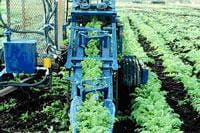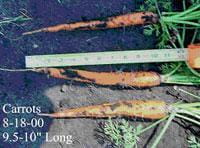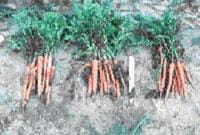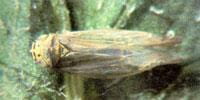Carrots (Daucus carota) grow well in Saskatchewan's climate and soils. The taproot is the edible portion of the carrot; the foliage has no economic value.
Soil Conditions

Gary Bishop, Atlantic Cool climate
Crop Research Centre, Agriculture and
Agri Food Canada)
Carrots favour well-drained, fine textured soils with good water-holding capacity. Sandy, loamy or muck-based soils are suitable for carrot production. A pH range of 5.5 to 8.0 is desirable. Carrot seedlings are very weak, and do not tolerate soil crusting. Seedbed preparation must eliminate clods as they interfere with uniform growth of the roots. Since the taproot is the edible portion of the plant, the field should be tilled to a 30 cm (12 inches) deep to ensure that root penetration is not restricted. Crusting of the soil surface will prevent the seedlings from emerging. For this reason, avoid clay soils.
Raised beds are very popular in carrot production as they help the soil warm up faster in the spring, promoting faster emergence. The soil tends to be very soft in the beds, which is crucial for weaker carrot seedlings.
Seed Treatment
It was once thought that a 50 per cent stand was good in carrot production, but better varieties and superior seed production practices now have increased that figure to 80 per cent or more. Due to the seed’s higher value, it is best to use seed treated with a fungicide, to prevent seedling blight, damping off and seed decay.
Pelleting carrot seed to increase its size improves the accuracy of planting and the uniformity of the carrot stand. Consult your local seed representative to get more information on precision seeding and seed pelleting.
Varieties
There are four main types of carrots:
Nantes

characteristic hot dog shape
2001 Scott Vlaun Seeds of Change
This is a popular carrot with a sweet taste. Nantes carrots are almost cylindrical in shape, and round off at the end rather than tapering off. They have a small core and a larger outer cortex. Sugars accumulate in the cortex, giving Nantes their sweet taste. Nantes carrots do not store for very long. They mature in early to mid-summer, and are usually eaten fresh.
Imperator

North Dakota State University.
All rights reserved.
This carrot type is the most commonly grown carrot because of its high yields and long storage potential. Imperators are long and tapered. They are a late-maturing variety, and generally have a larger, more fibrous core; therefore, they do not have the sweet taste of other carrot types.

Photo provided by the University of Florida.
Chantenay

slow taperto and rounded bottom
© 2001Scott Vlaun/Seeds of Change
Shape-wise, Chantenays are intermediate between a Nantes and an Imperator. They are tapered like the Imperator, but the bottom rounds off somewhat like the Nantes. Chantenays are also sweet tasting like the Nantes.
Danvers
Danvers are medium-length carrots, conical in shape, and thicker than Imperators. The end of the root is tapered. Danvers varieties are used in both the processing and commercial fresh market industries.
The University of Saskatchewan Plant Science Department has conducted carrot variety trials the last two decades.For a current list of recommended varieties refer to their website http://veg.usask.ca/
Seeding
Carrots should be planted early to mid-May in Saskatchewan. Seeding rates will depend on carrot type, the variety and the root size desired. General seeding rates are: 10 to 16 plants per 30 cm (12 inches) of row for Nantes varieties; and 12 to 18 plants per 30 cm (12 inches) of row for Imperator varieties. Higher carrot densities will give a higher total yield, but decreases average carrot size.
Row spacing can vary depending on equipment and planting practices. If planting in raised beds, the beds should be at least four inches off the ground on 51 to 102 cm (20 to 40 inch) centres. If planting in rows, inter-row spacing ranges from 41 to 76 cm (16 to 30 inches). Inter-row space is also dependant upon the row space capabilities of your tillage equipment and carrot harvester.
Carrot seed is small, and should be planted 1.9 to 2.5 cm (¾ inch to one inch) deep. Planting any deeper will slow emergence. Stanhay-type belt seeders are the most popular for carrots. Belts punched specifically to match seed size and desired spacing are available.
Fertility
Always base your fertilizer program on a soil test. Random soil samples should be collected from the entire field that you intend to plant. Due to climatic conditions, differing cultural practices, varying soil conditions and other situations, the crop's response to the fertility program may vary from region to region.
Carrots will require 80 kg/ha (71 lbs/ac) of nitrogen on muck soils, and 110 kg/ha (98 lbs/ac) of nitrogen on mineral soils. Phosphorus and potassium will be required in 120 kg/ha and 250 kg/ha (107 lbs/ac and 223 lbs/ac) amounts respectively. Always base your fertilizer rates on a soil test.
Over-application of nitrogen can lead to excess top-growth, which will slow the growth and development of the edible taproot.
Irrigation
Adequate amounts and proper timing of water are critical in carrot production. Carrots do not respond well to lack of water, particularly in high temperatures. Moisture is crucial for germination and root development. Watering at germination will also help to prevent soil crusting, thus promoting the growth of a new seedling.
For the bulk of the growing season, carrots require approximately 2.5 cm (1 inch) of water per week. Lack of water or inconsistent watering will lead to woody flavoured carrots and irregular growth patterns or misshapen roots.
Harvesting
Harvest occurs when carrots reach an adequate size. However, sweetness and storage potential increase with maturity. Avoid wounding carrots during harvest to reduce the incidence of sclerotinia in storage. Carrots are harvested either by cutting off the tops, called topping and using a digger to lift the carrots, or by using a machine to pull out the carrots by the tops, and then topping them in the field.
Topping usually occurs in the field, when most of the foliage is chopped off, with only 2.5 cm to 5 cm (1 to 2 inches) of stem remaining. The rest of the stem is usually trimmed off prior to packaging.
Cooler soil temperatures during harvest will reduce the amount of field heat that needs to be removed from the carrots when in storage. Avoid drying out the carrots between harvest and in storage.
Carrots do well in cooler weather, but they do not withstand freezing temperatures. Carrots, if frozen, will have ice crystals on the outside of the root. Allow the carrot to thaw before attempting to harvest. Symptoms of excessive freezing are: splitting of the root, water-soaked appearance, flabby or a watery breakdown. Discard any carrots that exhibit these symptoms.
Storage
Carrots should have their field heat removed as soon as possible after harvest. If possible, harvest the crop close to 0°C (32°F). Once in storage, the crop should be kept at 0°C (32°F) and 100 percent relative humidity to ensure minimal moisture loss. State of the art storages can store the product for six to nine months, while conventional storages can maintain quality product for four to five months.
Carrots should be cleaned and washed when they enter the storage. During the wash process, any damaged or diseased carrots should be discarded. Prior to harvest the storage area should be cleaned to kill any disease organisms that may be present. All contact surfaces should be dry before any product is stored.
Grades
The following are some of the requirements of carrots to be a Canada No. 1 grade:
- A minimum length of 114.5 mm (4.5 inches)
- A minimum diameter of 1.9 cm (.75 inches) in all cases (this depends on whether the package specifies a minimum and maximum diameter)
- Carrots cannot be soft, flabby or woody
- Carrots cannot be misshapen
- Carrots must be "reasonably clean," which means that they are practically free from caked dirt, mould or decaying matter and does not have more than 15 percent of the surface covered or stained.
- Carrots must be properly trimmed. They cannot be trimmed into the crown, the length of the crown does not exceed one inch and the length of 75 percent of the tops can not be more than one-half inch
* For complete grade standards requirements consult the Canadian Grade Compendium Vol. 2 included in the Safe Food for Canadians Act.
Pest Problems

Diseases
Aster Yellows – is caused by a phytoplasma (virus-like disease) spread by the aster leafhopper (Macrosteles quadrilineatus). Not all aster leafhoppers carry the pathogen. Do not plant carrots near fields planted to forage legumes or weedy areas where leafhoppers may be found. Many perennial crop hosts including medicinal species such as Echinacea are potential hosts for aster yellows. Symptoms of aster yellows include a witches’-broom appearance to the foliage, the growth of lateral, hairy roots from the taproot, and a yellowing and then bronzing of the foliage. Aster yellows are difficult to control because the cost of the insecticide is often greater than the economic damage incurred. A constant influx of aster leafhoppers will lead to the need for continued applications of insecticides.
Sclerotinia – caused bySclerotinia sclertiorum is a very significant disease in both the field and storage.Symptoms include foliage that is dark brown and coated with a whitish mould. Later on, black dots (sclerotia) will appear amid the white mould (mycelium). Infected carrots become soft and watery in storage. White mould covers the infected carrot, and the black sclerotia will follow. Control of sclerotinia begins with crop rotation and careful handling as carrots are harvested and put into storage. The storage units should be cleaned and disinfected prior to harvest. Avoid crop rotations with crops susceptible to sclerotinia, which include most all vegetable crops except sweet corn, beets, onions and spinach. Sclerotinia can persist in the soil for three to five years, therefore it is best to rotate with cereals and forages to break the disease cycle.
Applying registered fungicides in the field when putting in storage or trimming the lower outer carrot tops to increase the air flow also helps to minimize the disease.
Insects
Asterleafhopper – see above
Other Problems
Browning of root – caused by lack of moisture after harvest. Reasons for this include: harvest in hot conditions, delay in transporting carrots to storage, and failure to quickly cool the carrots once in storage. Carrots must be cooled to 0°C (32°F) as soon as they are harvested to ensure they store well.
Greening – will occur at the top shoulders of carrots due to exposure to sunlight. Tends to be a problem in light soils prone to wind or water erosion and when carrots are planted in raised beds. Hilling carrots during the season will help to control this. Thick stands create enough shade to protect the roots from the sun.
Misshapen roots – can be caused by a number of factors such as: a) hardpan, b) cultivars, c) compacted soil and d) over-irrigation. Hardpans prevent the root from growing straight down. Untimely or uneven precipitation causes the root not to grow straight. Deep tillage of the soil prior to planting may cure some of these problems, as well as ensuring a finely worked seedbed. Carrots do poorly in heavier soils. Longer rooted cultivars may be stunted or exhibit forking in these heavy soils. If you have heavier soils, the use of raised beds may be the better option for you.
